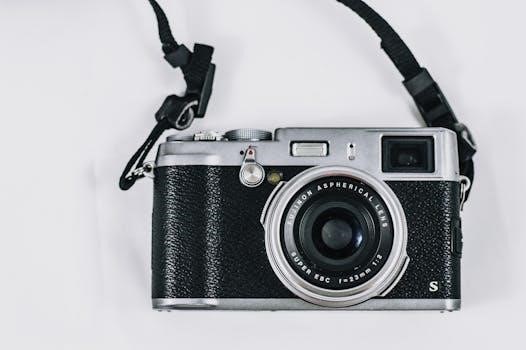Moultrie Trail Camera Manual⁚ A Comprehensive Guide
Moultrie trail cameras are essential tools for wildlife enthusiasts and hunters. This comprehensive guide provides resources for finding the correct manual for your camera model;
Finding Your Moultrie Trail Camera Manual
Finding the correct Moultrie trail camera manual is the first step to optimizing your camera’s performance. Manua.ls currently offers 90 Moultrie manuals divided into 6 categories. Moultrie‘s website, moultriefeeders.com, is an invaluable resource. Many manuals are available for download in PDF format. For older models, especially those from 2016 and earlier, you may need to contact Moultrie‘s Customer Success Team.
The Moultrie Team is available 7 days a week. Be sure to have your specific camera model number handy when searching online or contacting customer service to ensure you get the correct manual.
Moultrie’s Online Manual Resources
Moultrie provides numerous online resources to access trail camera manuals. The official Moultrie website (www.moultriefeeders.com) is a primary source, offering downloadable manuals in PDF format. You can find manuals for various camera models, including the A-Series and M-Series. Many online platforms also host Moultrie manuals, such as manualsonline and other user manual repositories.
These resources often include manuals for older models, although contacting Moultrie‘s customer support may be necessary for manuals of cameras from 2014 and earlier. Exploring these online resources can provide quick access to the information you need.
Manuals by Camera Model and Year
Finding the correct manual requires knowing your Moultrie trail camera’s model and year. Manuals are typically categorized by model series (e.g., A-Series, M-Series, Micro Series) and the year of manufacture. For example, the 2020 camera models often share the same interface and setup instructions.
For older cameras (2016 and earlier), specific links are available, while manuals for cameras from 2014 and older might require contacting Moultrie‘s Customer Success Team. Always ensure the manual matches your specific model to avoid incorrect setup or troubleshooting steps.
Understanding Your Moultrie Trail Camera
To effectively use your Moultrie trail camera, understanding its key components, battery installation, SD card setup, and how to navigate the camera interface is essential for optimal performance.
Key Components and Features
Understanding the key components of your Moultrie trail camera is crucial for effective use. These include the camera lens, infrared emitters for night vision, and a motion sensor to trigger image capture. Familiarize yourself with the external power port, which accepts the Moultrie Power Panel or Battery Box. Additionally, the LCD display shows camera settings, while the buttons allow for navigation and adjustments.
The status indicator LED provides feedback on the camera’s operational state. Appreciate these features to maximize your camera’s potential for capturing high-quality images and videos of wildlife.
Battery Installation and SD Card Setup
Proper battery installation and SD card setup are fundamental to operating your Moultrie trail camera. Typically, Moultrie cameras use AA batteries; ensure you follow the correct polarity (+ and -) as indicated in the battery compartment. Insert an SD card (up to 32 GB is often compatible) to store your captured images and videos.
Refer to your specific model’s manual for recommended SD card types and battery specifications. A correctly installed SD card and fresh batteries are essential for optimal performance. Always format the SD card within the camera for compatibility and reliability before use.
Navigating the Camera Interface
Understanding the camera interface is crucial for customizing your Moultrie trail camera settings. Most models feature an LCD display and buttons for navigation. Common buttons include OK, Up, Down, and Menu. Use these buttons to access settings like date, time, image resolution, and trigger sensitivity.
The interface allows you to configure recording modes (photo, video, or hybrid), delay settings, and other advanced features. Familiarize yourself with the menu structure to efficiently adjust camera parameters. Each model’s manual provides a detailed walkthrough of the interface and available options, ensuring you can optimize the camera for your specific needs.

Setting Up Your Moultrie Trail Camera
Proper setup ensures optimal performance for your Moultrie trail camera. This section covers initial activation, configuring settings like date and time, and physically mounting the camera for effective surveillance.
Initial Setup and Activation
Begin by opening the camera and installing the recommended batteries, paying attention to the correct polarity. Insert an SD card, up to 32 GB, which is not included typically. Visit Moultrie’s website for warranty activation after verifying all components are correctly installed, such as attaching the antenna if applicable. For cellular models, an active Moultrie Mobile account is required; create one at MoultrieMobile.com. Follow the quick-start guide in the owner’s manual for the antenna connection and SD card preparation. Ensure the camera powers on correctly before proceeding to the next configuration steps.
Configuring Date, Time, and Camera Settings
Access the camera’s menu to set the date and time accurately; this is vital for tracking wildlife activity. Adjust camera settings such as photo resolution and trigger delay to optimize image quality and capture frequency. Review the manual for specific instructions on navigating the camera interface. Explore options like managed memory, adjustable delay, and capture settings. Some 2020 models have the same interface and setup instructions, though color differences may exist. Refer to your specific model’s manual for detailed guidance. Correct settings ensure optimal performance.
Mounting and Positioning Your Camera
Securely mount your Moultrie trail camera to a tree or post using the appropriate straps or mounting brackets. Position the camera to capture the desired field of view, considering the anticipated animal movement patterns. Clear any brush or obstructions that might trigger false positives or obscure images. Experiment with different angles and heights to achieve the best results. Aim to minimize direct sunlight exposure to prevent lens flare and overexposure. Proper mounting and positioning significantly improve the camera’s effectiveness in monitoring wildlife activity. Ensure the camera is stable to avoid blurry images.

Troubleshooting Common Issues
Addressing issues such as camera not powering on, image quality problems (like black night photos or pink daytime photos), and triggering problems are crucial for ensuring optimal performance of your Moultrie trail camera.
Camera Not Powering On
If your Moultrie trail camera fails to power on, begin by checking the batteries. Ensure they are correctly installed, matching the indicated polarities. Try using a fresh set of batteries, as low battery power is a common culprit. Inspect the battery compartment for any signs of corrosion or damage, which could impede electrical contact.
Verify that the power switch is in the “ON” position. If the issue persists, consult your specific model’s manual for troubleshooting steps, or contact Moultrie’s customer support team, available seven days a week, for further assistance and guidance to resolve the problem.
Image Quality Problems (Black Night Photos, Pink Daytime Photos)
Experiencing black night photos or pink daytime photos with your Moultrie trail camera? For black night photos, ensure the camera is not obstructed and the infrared (IR) illuminators are functioning. Low batteries can also affect IR performance. If daytime photos appear pink, this could indicate an issue with the IR filter.
Try performing an IR filter reset as described in your camera’s manual. If problems persist, check the SD card for compatibility and sufficient storage space. If issues continue contact Moultrie’s customer support team, available seven days a week, for personalized troubleshooting advice.
Triggering and Detection Issues
If your Moultrie trail camera isn’t triggering or detecting motion, several factors could be responsible. Ensure the camera is positioned correctly and the detection range is appropriate for your environment. Obstructions like tall grass or branches can interfere with the sensor. Check the camera’s settings, including sensitivity and delay, to ensure they are optimized for your needs.
Low battery power can also affect detection capabilities. Confirm that the batteries are fresh and properly installed, following the correct polarities. Inspect the lens for dirt or debris that might impede detection. Review the user manual for troubleshooting steps specific to your model.

Moultrie Mobile Connectivity
Moultrie Mobile connectivity allows you to remotely access images from your trail camera. This section guides you through setting up an account, activating your camera, and using the mobile app.
Setting Up a Moultrie Mobile Account
To leverage the remote capabilities of your Moultrie trail camera, setting up a Moultrie Mobile account is the first step. Visit MoultrieMobile.com using a computer or download the Moultrie Mobile app on your smartphone. Follow the on-screen prompts to register, providing the necessary information such as your name, email address, and a secure password. You may need to verify your email address through a confirmation link sent to your inbox. Choose a data plan that suits your needs, which may involve a subscription fee. This account will serve as the central hub for managing your connected cameras and viewing captured images remotely.
Activating Your Camera on Moultrie Mobile
Once your Moultrie Mobile account is set up, the next step is to activate your camera. Locate the camera’s serial number and activation code, usually found inside the battery compartment or on the camera packaging. Log in to your Moultrie Mobile account via the website or app, and navigate to the “Activate Device” or similar section. Enter the camera’s serial number and activation code when prompted; Follow the instructions to link the camera to your account and select your desired settings. Ensure your camera has sufficient battery power and a compatible SD card installed before initiating the activation process.
Using the Moultrie Mobile App
The Moultrie Mobile app is your central hub for managing your connected trail cameras. After activating your camera, use the app to view and manage captured images and videos. The app allows you to sort images, apply filters, and tag specific events. You can also adjust camera settings remotely, such as trigger sensitivity, image resolution, and transmission frequency. The app provides notifications for new images, battery levels, and camera status. Familiarize yourself with the app’s navigation and features to optimize your trail camera management experience. Regularly check for app updates to ensure compatibility.

Power Options and Accessories
Maximize your Moultrie trail camera’s performance with various power options and accessories. Explore external power sources, SD card compatibility, and additional equipment to enhance your camera’s functionality and longevity in the field.
Using External Power Sources (Moultrie Power Panel, Battery Box)
Extend the operational life of your Moultrie trail camera by utilizing external power sources such as the Moultrie Power Panel or a Moultrie Battery Box. These accessories provide a reliable and continuous power supply, reducing the need for frequent battery replacements, especially during extended surveillance periods. When using external power, ensure compatibility and follow the manufacturer’s instructions to avoid damaging your camera. The Moultrie Power Panel typically uses solar energy to trickle-charge a connected battery, while the Battery Box offers a larger capacity for extended use. Only use Moultrie accessories to avoid voiding warranty.
Compatible SD Cards
Selecting the correct SD card is crucial for optimal Moultrie trail camera performance. Moultrie cameras typically support SD cards up to a specific capacity, such as 32GB, to ensure proper data storage and retrieval. Always refer to your camera’s manual for the recommended SD card type and maximum capacity. Using an incompatible or low-quality SD card can lead to issues like corrupted images, slow performance, or camera malfunction. Ensure that the SD card is properly formatted before use. Regular formatting helps maintain the card’s efficiency and prevents potential errors.
Other Accessories
Enhance your Moultrie trail camera setup with a range of accessories designed to improve performance and functionality. Consider using a security box to protect your camera from theft or damage, especially in high-traffic areas. Adjustable mounting brackets offer flexible positioning options for capturing the best angles. External antennas can improve cellular connectivity for Moultrie Mobile cameras, ensuring reliable image transmission; Cable locks provide an additional layer of security, preventing unauthorized removal of your camera. Explore these and other accessories to maximize the effectiveness and longevity of your Moultrie trail camera system.
